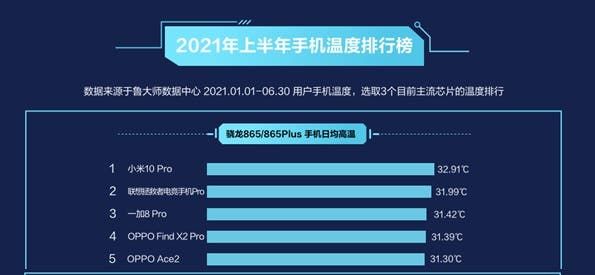Over the past few days, we have been posting the top smartphones that tend to overheat. A few days ago, we had a post on the top 10 Snapdragon 888 that tends to overheat. Subsequently, we had another post on the top 5 Snapdragon 870 smartphones that overheats. Now, we have the top 5 Snapdragon 865 smartphones that overheat. Since Qualcomm tries to ram up the performance of its chips, these processors are susceptible to heating. However, with a good heat dissipation system and a proper heat sink, smartphone manufacturers can effectively reduce the heating effect. It is a menace to have smartphones that overheat up in your hand after a few hours of usage. Thus, it is important for potential buyers to be adequately informed. Master Lu recently tested the temperature emission of Snapdragon 865 smartphones. Here are the top 5 Snapdragon 865 / Snapdragon 865+ smartphones that overheat.

1. Xiaomi Mi 10 Pro 5G - Average temperature is 32.91°C
The Xiaomi Mi 10 Pro comes with a three-dimensional cooling system. According to the company, the cooling system of this smartphone ensures a 10.5 °C CPU temperature reduction. It uses a VC Liquid Cooling with a super large vapor chamber surface area + 6-stack graphite layer + heat-transmitting gel, According to reports, at the time of its launch, it has the largest VC heat-dissipating board which is three times larger than the VC board of the Mate30 Pro 5G version. The VC heat dissipation area is 3000 mm² and this smartphone also supports intelligent thermal control (smart CPU frequency and current control).
This smartphone uses a graphene heat dissipation material, which dissipates heat for core flagships such as processors. Furthermore, the large copper foil and thermally conductive gel wrap around every part of the cooling system. are used to cover every small detail inside the machine. This design will ensure that the smartphone runs on seamlessly during long-hour gaming. Despite this "robust" cooling system, the Xiaomi Mi 10 Pro 5G has the highest average temperature on the list. According to Master Lu, the temperature of this phone is as high as 32.91°C
2. Lenovo Legion Pro - Average temperature is 31.99°C
This is the only Snapdragon 865+ smartphone on the list and it is a powerful gaming smartphone. We can all understand why it is number two on this list. However, the fact that there is only one Snapdragon 865+ smartphone on the top 5 list implies that in terms of heat dissipation, the Snapdragon 865+ is better optimized than the Snapdragon 865 SoC.
This device comes with a 144 Hz refresh rate display and other gaming features that increase the temperature. However, it uses a dual liquid cooling system so as to get the best gaming experience without any overheating and lagging issues. The company uses a frosted liquid within the dual liquid system. This cooling system comes with a 14-point temperature control matrix to monitor the body temperature in real-time. According to Master Lu's ranking, the Lenovo Legion Pro which was released in 2020 has an average temperature of 31.99°C and it has the second-highest overheating temperature for Snapdragon 865 / 865+ devices.
3. OnePlus 8 Pro - Average temperature is 31.42°C
OnePlus have not had a good time with heating issues as the OnePlus 8 series and mostly the OnePlus 9 series had had series of heating issues. The OnePlus 8 Pro supports up to 30W wireless fast charging, new camera sensors, a bigger battery, a more powerful processor, and a higher refresh rate display. Compared to the OnePlus 7T Pro, that's a pretty big upgrade and some of these upgrades have an impact on the heating.
The OnePlus 8 series comes with integrated cooling pipes for heat dissipation. However, these smartphones (OnePlus 8 and OnePlus 8 Pro) do not come with liquid cooling. Nevertheless, the average temperature of this smartphone is just 31.42°C. At this rate, users may not even notice the temperature increase.
4. Oppo Find X2 Pro - Average temperature is 31.39°C
The Oppo Find X2 Pro was officially released in March 2020. This smartphone comes with a 4260 mAh battery that supports 65W SuperVOOC 2.0 super flash charge fast charging. According to the company, this charging power can give this smartphone a full charge in just 35 minutes. While users will enjoy the super fast charge of this device, it has its shortcoming which is basically heating. Heating issues in a smartphone are usually not due to the processor alone. Here, Oppo had to use an internal heat dissipation system that reduces the temperature of this smartphone. The Oppo Find X2 Pro comes with a triple thermal dissipation system. The device comes with a thermal conductive gel, a vapor chamber liquid cooling as well as multilayer graphite. The aim of these materials is to reduce the temperature of this device. This system pays off as the average temperature of this device is 31.39°C which is minimal
5. Oppo Ace2 - Average temperature is 31.30°C
According to Master Lu's rating, the Oppo Ace2 has an average temperature of 31.30°C. However, some reviews show that the temperature can get as high as 36.9°C during wired charging. There are reports that the wireless charging of this smartphone could raise the temperature to 41.2°C. However, these temperatures are only possible during charging. On normal average usage, the temperature does not get anywhere this high.
The heat dissipation consists of two long bar-shaped heat sinks. The AirVOOC charging comes with a board fan and there is a heat dissipation grille at the bottom of the phone to take care of the heat generation issues.
Conclusion
The conclusions here are basically the same for any ranking of processors that overheats. We are aware that overheating problems can be annoying, especially when you have a flagship smartphone. However, it is important to note that overheating issues can be the result of either hardware or software issues. Thus, the Snapdragon 865 /865+ SoC may not be the sole reason for the heating issues on even mid-range smartphones. We must also emphasize that on a daily usage, most of these smartphone does not come anywhere near the average temperature. Furthermore, to curb the heating issues, the smartphone manufacturer needs to do a lot of optimizations. The higher the heat of a smartphone, the lower the performance of the device, this is why most smartphones need a good heat dissipation system.






Place comments
0 Comments
You are currently seeing only the comments you are notified about, if you want to see all comments from this post, click the button below.
Show all comments